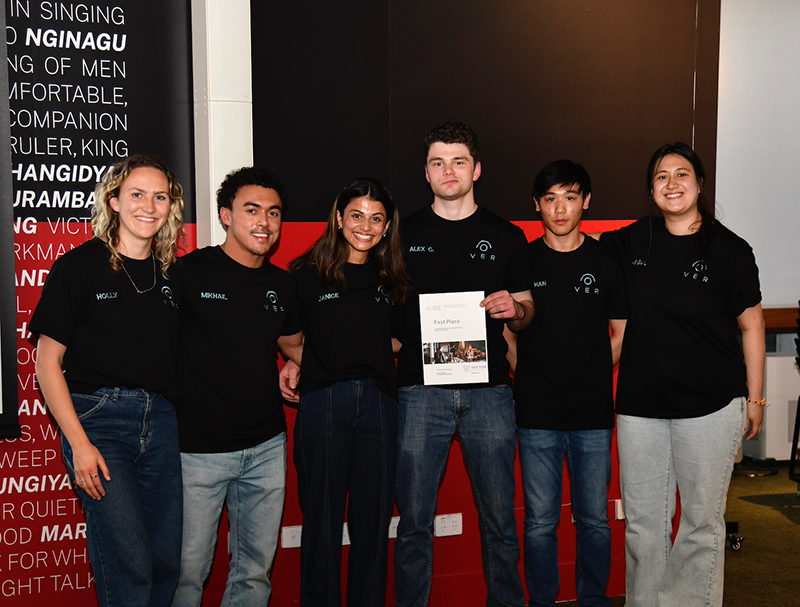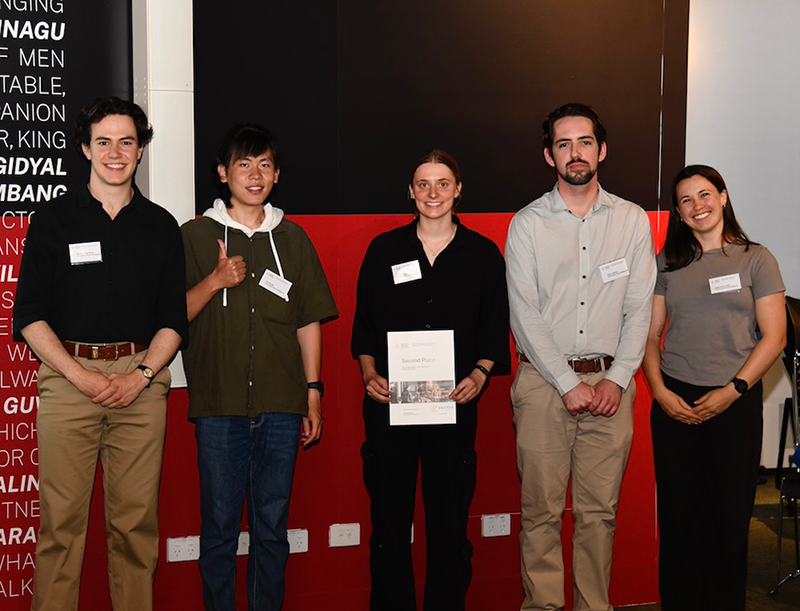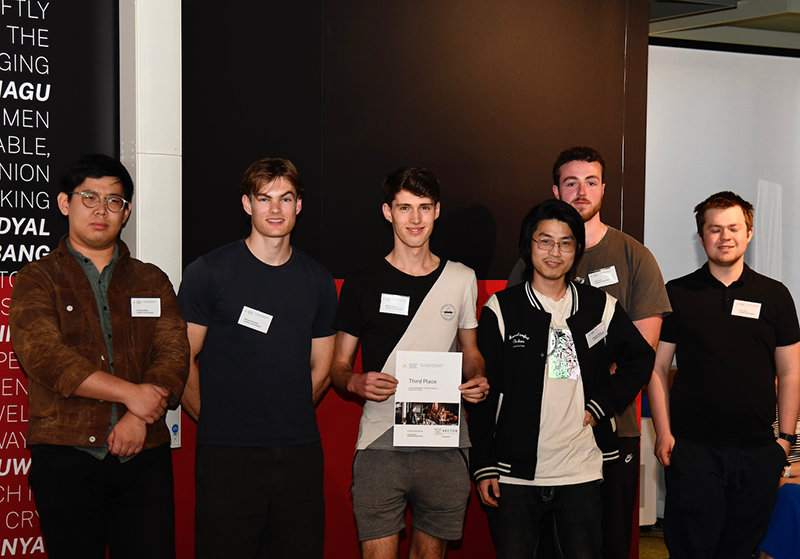The Capstone Design Project course is a hallmark of The Australian National University (ANU) engineering curriculum. In Capstone, our final-year engineering students navigate a real-world engineering project under the guidance of industry partners and academic mentors.
To mark the year-long culmination of their hard work, students recently presented their innovative solutions at the 2024 Capstone Showcase.
We spoke to the student teams who took out the three top spots on the day, recognising the value their projects delivered for industry clients.
An independent vision: Project Ver

For more than 450,000 Australians with vision impairment, navigating everyday life can present numerous unique challenges. ANU Capstone team ‘Project Ver’ embraced this opportunity head-on. They designed an innovative solution: a hands-free wearable device for interacting with your surroundings.
“We hoped to address a critical need for people that is often overlooked; developing hands-free, real-time support for vision-impaired individuals in daily settings,” shares Janice Rebello, a member of Project Ver.
The team’s journey was rooted in human-centred design; and included months of consultation with those who are blind and vision-impaired, as well as support workers and advocates in their community.
The resulting Ver device is a small, discreet camera and buttons embedded in the strap of a stylish cross-body bag. It allows users to capture images of their surroundings and receive real-time audio feedback without needing to reach for a smartphone.
Their prototype version focuses on grocery store navigation, a common activity that challenged vision-impaired individuals. Ver can read labels and signs, then answer questions with relevant and tailored responses using conversational artificial intelligence (AI).
“A custom Large Language Model, like ChatGPT, is the star of this innovation. It enables our device to communicate in a way that feels intuitive and conversational, giving users the ability to ask questions and receive responses in real-time,” explains Janice.
“By understanding and responding to everyday language, Project Ver creates a more accessible, human-centred experience. The device reduces reliance on traditional assistive technologies, which often require a more complex learning curve or less flexible input methods.”
Looking ahead, the Project Ver prototype has potential in many other settings. The technology could transform lives by supporting vision-impaired individuals to use public transport, summarise documents, and understand signage around campus.
The innovative engineering pitch saw the Project Ver student team gain valuable experience and take home first place in this year’s Capstone showcase.
“Being able to show off our product at the Capstone showcase was such a highlight. It felt like the ultimate culmination of everything we had spent the year working toward. Seeing our vision be materialised, and watching it spark genuine interest and enthusiasm from attendees was unforgettable.”
– Janice Rebello.
Every minute counts: Community Flood Intelligence

105 minutes. That’s how long residents in Lismore, New South Wales, had to evacuate before floodwaters engulfed their homes in 2022. Inspired by the need to better prepare and equip communities, the ‘Community Flood Intelligence’ team engineered a timely solution for flood-prone areas of Australia.
“During floods, communication infrastructure breaks down—leaving you without mobile reception or internet. People are forced to rely on inaccurate weather updates from sources that aren’t local or in real-time,” the team presented during the showcase.
The team developed a decentralised network of rainfall and creek-level sensors that work without mobile or internet reception. The sensors deliver real-time data and critical weather information through the radio every 10 to 15 minutes; which is eight times more frequent than existing systems.
The technology has built-in redundancy to deliver reliable and clear information to local communities in an emergency. Designed to be affordable and open-source, it can be scaled and adapted to other flood-prone regions.
“The system is designed to be affordable for smaller communities and to provide relevant information about the local region. For example, the water levels under key bridges,” says team member Bartholomew Bunk.
During the yearlong Capstone course, teams define and scope their project with the client to tailor and manage the system lifecycle processes.
“For me, the best part of the project was being able to develop the system from the ground up. Through prototyping, to building, and finally deploying. It was fun to design a system that included electrical, structural and software subsystems working together,” says Bartholomew.
“Capstone prepares you for the real world; working in a team to develop a working engineering system. It also requires you to show initiative, which will be highly valuable in the workforce,” he adds.
Rethinking composting: Lyrebird Instruments

New government mandates across Australia will soon require organic waste to be separated from landfill. With the growing focus on sustainability, team ‘Lyrebird Instruments’ presented a game-changing solution for smarter composting.
Large-scale composting is a highly labour-intensive and manual process, prone to human error. This could lead to huge amounts of unintentional greenhouse gas emissions.
“Currently, these facilities have no system for monitoring the waste pile autonomously. They rely on manual measurements, usually at extremely large time intervals,” says team member Martin Hosking.
“We were tasked with making a probe that can be inserted into a pile of compost, and measure the relevant parameters such as oxygen levels, temperature, moisture content and CO2 levels.”
The resulting autonomous system prototype is lightweight and can measure up to 1.3 metres inside a compost pile. It provides precise, continuous real-time monitoring of data, which is wirelessly transmitted to a central database for easy access.
The move to data-driven decision making would see waste facility operators alerted when the optimal time is for turning, aerating, and watering their compost piles.
“The Lyrebird Instruments probe has the potential to be a powerful tool in Australia’s goals of reaching net zero and building a greener society,” the team presented during the showcase event.
The prototype plans to be further developed with a longer battery life and additional sensors in the future.
“By optimising and automating some of the most labour-intensive and time-consuming functions of large-scale composting, we’re turning one of our biggest environmental challenges into an opportunity for a more sustainable future.”
The future of Capstone
As another year of Capstone courses wraps up, ANU students continue to impress by engineering designs that make a positive impact on society.
Reflecting on this year’s projects, course convener Dr Zena Assaad shares,
“Capstone gave our students an opportunity to work closely with industry on solving real-world problems. Our students excelled in this year’s projects, tackling problems around communication networks during times of flood, accessibility for the visually impaired, improving recycling across the ANU and many more.”
The showcase also recognised the ‘Neutron Activation’ team, which drew attention from attendees and won the audience choice award for their vibrant poster on neutron-related studies and experiments. Team ‘Relativity Escape Room’ earned an honourable mention for its creative approach to education – using a portable escape room to teach high schools complex scientific concepts. The Capstone Design Project (ENGN4300) immerses students in authentic engineering-based experiences, equipping students with the autonomy needed as graduate engineers while building job-ready skills that are attractive to employers.
“Capstone has given me so much experience and so many new skills that you simply wouldn’t be able to get in any other course.” – Martin Hosking.
The call for Semester 1 2025 projects is now open. New projects will begin in February and July 2025. If you have any questions, please contact engn4300.cecc@anu.edu.au.
—
Learn more about the Capstone Design Project course
Read about last year’s Capstone showcase
—
More Capstone Projects:
Drone security leads to job security 6 months before graduation

